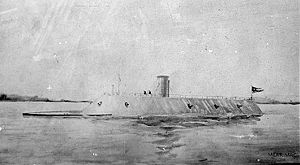March 9
1862. A completely inconclusive and inconsequential battle between two ships in the Civil War heralds the dawn of a new era in warships. The USS Monitor battled the CSS Virginia (built in part using the remains of the USS Merrimac) off Hampton Roads, Virginia.
The USS Monitor:

An ungainly, low-in-the-water, barely seaworthy vessell, the Monitor was little more than an armored raft. She had been built very rapidly as a result of the Union's knowledge of the construction of the Virginia as an ironclad. It nearly sank as it was towed into place from Brooklyn to Virginia to ensure that the blockade of Hampton Roads continued. She arrived in the nick of time. On March 8th, the Virginia had come out and sank both the USS Cumberland and the USS Congress, two 50 gun frigates that were on blockade duty. The next day the Virginia slipped her moors and went to destroy the rest of the blockading force, but found the Monitor in her way.
The battle lasted 4 hours, with neither ship seriously damaging the other. At that point, the ships' defenses were far superior to their firepower.
Swamped by high waves while under tow, the Monitor sank on December 31, 1862 with a loss of 16 of her 160 crew members. In 1973, the remains of the wreck were found about 16 nautical miles south of Cape Hatteras. Portions of teh ship have been raised and are on display at the Mariners' Museum in Newport News, Virginia.
The CSS Virginia failed in her msision to break the Union blockade, though she sortied out several times to offer battle to the Monitor, which consistently refused after the first fight, and she went on to capture a few merchant vessels.
The CSS Virginia:

On the first day of the Battle of Hampton Roads, the Virginia sank the USS Cumberland by ramming her, but in sinking, the Cumberland performed a final service by breaking off the Virginia's ram. The first day of battle also did damage to the Virginia's smokestack, reducing her already pathetically slow speed.
Requiring a much deeper draft than the Monitor, and being a much slower vessel, the Virginia was unable to reenage the Monitor, which stayed in the shoals, despite various efforts to offer battle. On May 10, 1862, with the Union Army engaged in McClelland's Peninsula Campaign, Norfolk, Virginia was occupied (see side-story below). Unable to advance further up the James River due to her deep draft, and not sufficiently seaworthy for the open seas, the Virginia was blown up to prevent her capture.
Peninsula Campaign / Norfolk Side Story. The capture of Norfolk, Virginia, is in itself a fascinating little historical nugget. The port at Hampton Roads is one of the best in the world, and the current home of the US Navy's Norfolk Navy Base. While engaged in the Peninsula Campaign, Union Commander General McClelland was visited by President Lincoln, Secretary of War Stanton and Secretary of the Treasury Salmon Chase, who arrived at Fort Monroe on May 6th. McClellan, whose arrogance match that of any US military leader before or after, claimed he was too busy to meet the President and Secretary of War.
Lincoln strongly felt that Norfolk was vulnerable and could be captured. He very much wanted it captured for the benefit of the Navy, but being ignored by McClellan, decided to undertake the mission himself. He ordered a naval bombardment on shore and then -- incredibly -- after consulting with a local pilot familiar with the shore region, did a personal reconnaissance of the opposing shore, along with the two cabinet members in order to find an unopposed landing point. Troops were ferried across the river, and the troops entered the city a day or two later, encountering little resistance.
Thus, President Lincoln himself was directly responsible for the capture of Newport, Virginia, the loss of that key port to the Confederates (it remained in Union hands for the rest of the war), and the destruction of the CSS Virginia. And in the words of Secretary of the Treasury Salmon P. Chase:
"So ended a brilliant week's campaign by the President."
http://www.norfolkhistorical.org/highlights/46.html